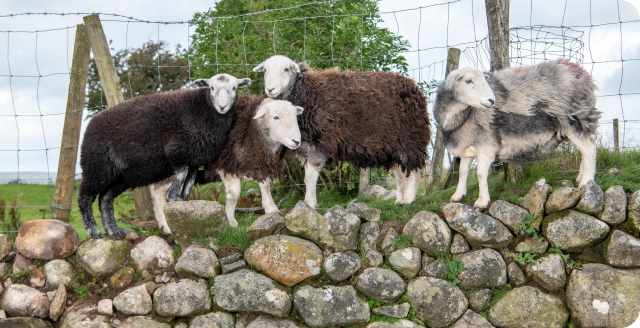Natural Herdwick sheep wool is an incredible material. It's a natural biodegradable substance with a multitude of uses.
So what makes Herdwick sheep wool so good?
Sheep wool has some amazing properties - unlike what you can find in synthetic materials.
Firstly it is incredibly hygroscopic - meaning it can absorb significant amounts of water without becoming significantly wet or heavy - this makes it a fantastic gardening material as raw wool is able to hold a large quantity of water compared to its raw weight - placing a little on top of plants can ensure they have sufficient water to grow well.
It is also rich in nitrates and other nutrients - when wool biodegrades down it releases lots of minerals including nitrates - these are essential to encourage plant growth!
It's 100% natural and biodegradable - unlike many synthetic products you can be rest assured if you use this in your garden or home it contains no plastics, chemicals or other nasties - also when you're done with it you can be sure it will simply degrade away, and not end up in our oceans or land fills!
Wool is a great insulator, draught stopper and sound proofer - wool is a fantastic absorber, it absorbs the energy from sound waves helping to dampen sound. It physically blocks draughts - we use wool every day to produce our very effective Chimney Sheep! It also traps air in between its fibres helping to keep warmth in homes, and preventing heat escape via conduction.
Wool absorbs chemicals - by using wool in your home you are helping to reduce the number of chemical nasties present in your day to day life - wool has been shown to be a very efficient absorber of chemical gases such as formaldehyde and others which may be present in glues, plastic and electrical equipment around your home.
Wool is a fantastic carbon store, the processes used to grow and produce wool mean that wool is loaded with carbon dioxide that would otherwise be in the atmosphere - in fact carbon makes up to 50% of the weight of wool!
How much Herdwick Sheep Wool do you get in the pack?
Wool isn't very heavy so a kilo is quite a lot. We squash it into a box that's 27cm x 41cm x 28cm. That's about 0.03 of a cubic metre. We do more than just the one kilo now, with our largest 7kg box measuring 77cm x 50cm x 50cm - the rest are somewhere in between, but since we try and reuse boxes where we can, we can't be sure what size box they will come in.
What can Herdwick Sheep Wool be used for?
Wool is amazingly versatile stuff. It's a brilliant replacement for moss in hanging baskets. Moss is taken from forests and shipped in from places as far afield as Chile. Wool holds moisture and delivers nutrients as it slowly biodegrades. It’s the perfect replacement for moss! And our 1kg box will do a lot of baskets. While you’re in the garden it also works as an excellent biodegradable mulch.
As you know there are a whole load of products that are made from wool for heat and sound insulation. But the wool on its own can be used for all kinds of things such as poking into gaps around your home or using as sound absorption in various applications.
I love hearing about all the crafty uses that skilful artists use it for. Spinning, needle felting, wet felting, as a filler for soft toys, cushions and door draught excluders…the wool contains a lovely range of natural colours and textures that can be used in all kinds of imaginative ways. In fact please send us pictures of your projects, we’d love to show them off on Facebook!
Another amazing property of wool is that it absorbs VOC’s from the air. VOC’s are emitted by all kinds of household products from nail varnish remover to cleaning products to varnishes and things that give off that “new” smell. These have serious health implications. The molecules in the VOC’s bind permanently to the wool fibres. The wool effectively cleans the air around your home, in your car or place of work or education. We are sure you can come up with other clever uses of wool!
Why this wool?
Our wool in particular is sourced directly from farmers in the Lake District, it's completely Herdwick Sheep wool - it has no added chemicals and has simply been washed, so it's nice and clean ready for use! All our wool is sourced from farmers we know - it's local , and hasn't travelled very far - it's even scoured (washed) in nearby Yorkshire - so this wool hasn't even travelled out of North England!






